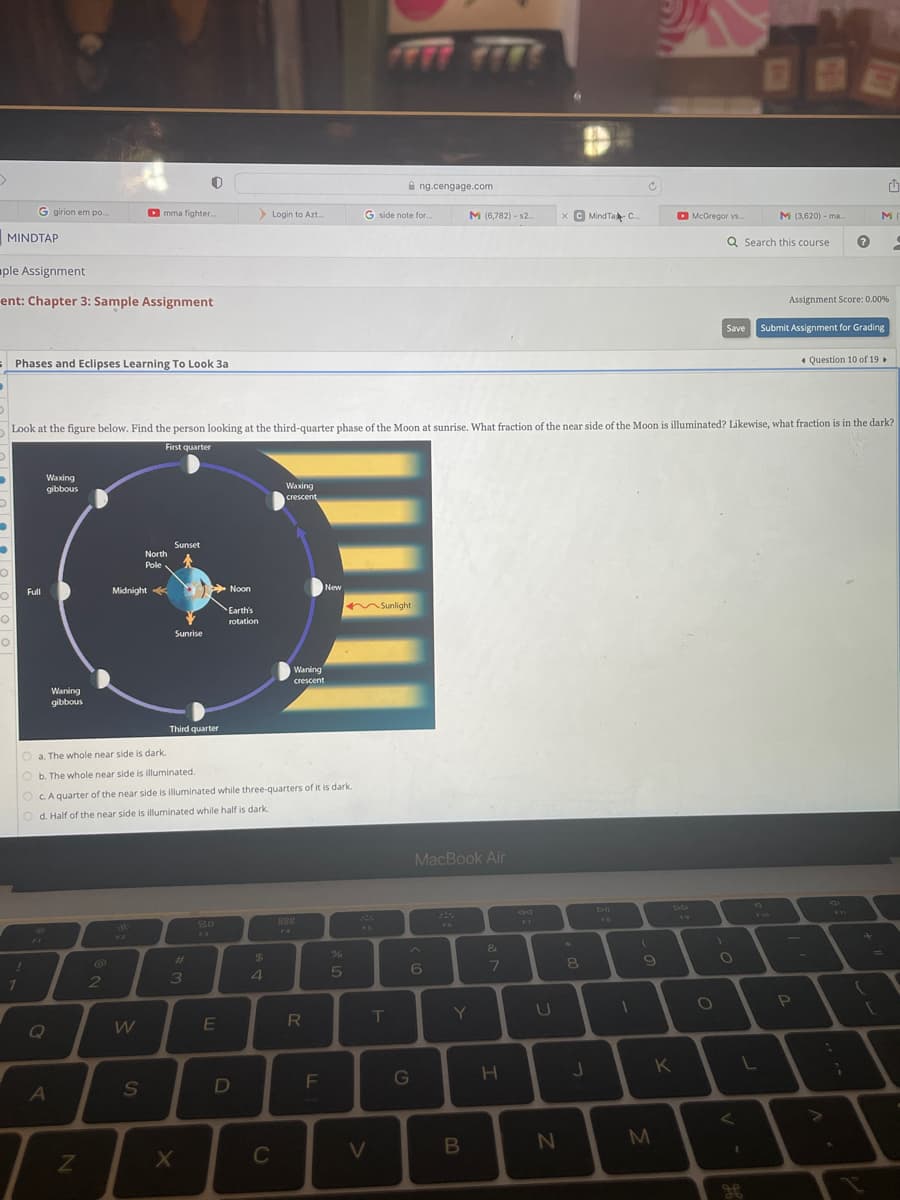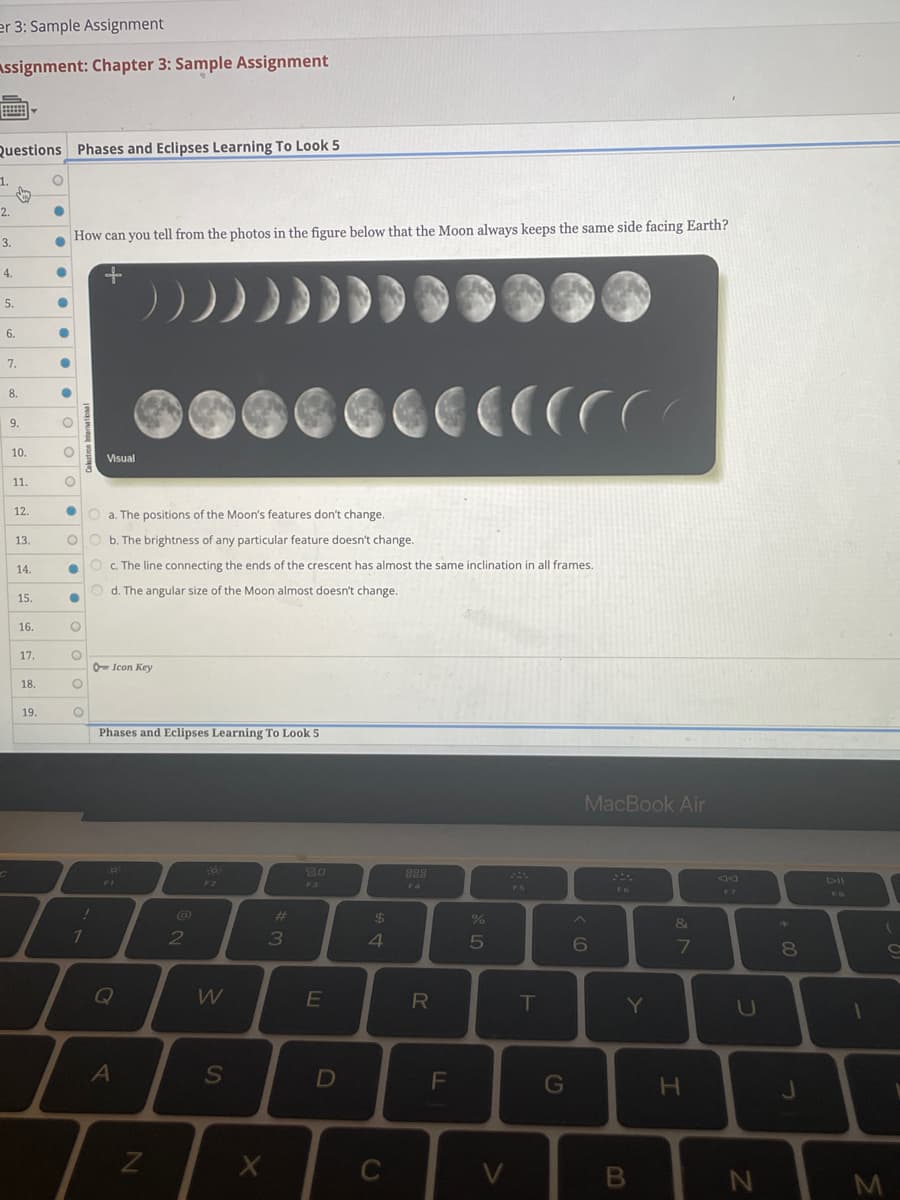Phases and Eclipses Learning To Look 3a Look at the figure below. Find the person looking at the third-quarter phase of the Moon at sunrise. What fraction of the near side of the Moon is illuminated? Likewise, what fraction is in the dark? First quarter Full Waxing gibbous Waning gibbous North Pole Midnight Sunset Sunrise Third quarter Noon Earth's rotation Waxing crescent New Waning crescent a. The whole near side is dark. b. The whole near side is illuminated. c. A quarter of the near side is illuminated while three-quarters of it is dark. Od. Half of the near side is illuminated while half is dark. Question 10 of 19 Sunlight
Phases and Eclipses Learning To Look 3a Look at the figure below. Find the person looking at the third-quarter phase of the Moon at sunrise. What fraction of the near side of the Moon is illuminated? Likewise, what fraction is in the dark? First quarter Full Waxing gibbous Waning gibbous North Pole Midnight Sunset Sunrise Third quarter Noon Earth's rotation Waxing crescent New Waning crescent a. The whole near side is dark. b. The whole near side is illuminated. c. A quarter of the near side is illuminated while three-quarters of it is dark. Od. Half of the near side is illuminated while half is dark. Question 10 of 19 Sunlight
Applications and Investigations in Earth Science (9th Edition)
9th Edition
ISBN:9780134746241
Author:Edward J. Tarbuck, Frederick K. Lutgens, Dennis G. Tasa
Publisher:Edward J. Tarbuck, Frederick K. Lutgens, Dennis G. Tasa
Chapter1: The Study Of Minerals
Section: Chapter Questions
Problem 1LR
Related questions
Question

Transcribed Image Text:>
MINDTAP
●
ple Assignment
ent: Chapter 3: Sample Assignment
D
-
O
O
O
O
G girion em po...
Phases and Eclipses Learning To Look 3a
!
1
Full
Waxing
gibbous
Q
Waning
gibbous
A
N
@
2
▸mma fighter....
Midnight
ad
M
W
North
Pole
S
Look at the figure below. Find the person looking at the third-quarter phase of the Moon at sunrise. What fraction of the near side of the Moon is illuminated? Likewise, what fraction is in the dark?
First quarter
Oa. The whole near side is dark.
b. The whole near side is illuminated.
O
c. A quarter of the near side is illuminated while three-quarters of it is dark.
Od. Half of the near side is illuminated while half is dark.
Sunset
4
Sunrise
Third quarter
3
X
Noon
E
Earth's
rotation
> Login to Azt.....
D
$
4
Waxing
crescent
C
Waning
crescent
New
R
F
%
ла
5
G side note for...
FD
V
Sunlight
ng.cengage.com
T
G
6
MacBook Air
M (6,782) - s2...
F6
Y
B
&
7
H
F7
U
N
XC MindTaC...
EN
*
8
J
bil
C
1
(
9
M
DD
McGregor vs...
K
O
Q Search this course
O
<
Save Submit Assignment for Grading
1
M (3,620)-ma.
9
L
H
Assignment Score: 0.00%
?
P
Question 10 of 19
11
:
M
;
1
2

Transcribed Image Text:er 3: Sample Assignment
Assignment: Chapter 3: Sample Assignment
Questions Phases and Eclipses Learning To Look 5
1.
2.
3.
4.
5.
6.
7.
8.
9.
10.
11.
12.
13.
14.
15.
16.
17.
18.
19.
O
●
●
●
●
●
●
How can you tell from the photos in the figure below that the Moon always keeps the same side facing Earth?
+
●
O
O
●
O
● O a. The positions of the Moon's features don't change.
O Ob. The brightness of any particular feature doesn't change.
● O c. The line connecting the ends of the crescent has almost the same inclination in all frames.
Od. The angular size of the Moon almost doesn't change.
O
O
O
O
!
1
Visual
))))))
Icon Key
Phases and Eclipses Learning To Look 5
F1
Q
A
N
@
2
BO
W
S
X
#
3
20
F3.
E
D
$
4
C
888
R
F
%
5
V
T
G
MacBook Air
^
(0
6
Y
B
&
M
7
H
ad
F7
N
*
00
8
DII
1
M
(
9
Expert Solution
This question has been solved!
Explore an expertly crafted, step-by-step solution for a thorough understanding of key concepts.
This is a popular solution!
Trending now
This is a popular solution!
Step by step
Solved in 2 steps

Recommended textbooks for you

Applications and Investigations in Earth Science …
Earth Science
ISBN:
9780134746241
Author:
Edward J. Tarbuck, Frederick K. Lutgens, Dennis G. Tasa
Publisher:
PEARSON

Exercises for Weather & Climate (9th Edition)
Earth Science
ISBN:
9780134041360
Author:
Greg Carbone
Publisher:
PEARSON

Environmental Science
Earth Science
ISBN:
9781260153125
Author:
William P Cunningham Prof., Mary Ann Cunningham Professor
Publisher:
McGraw-Hill Education

Applications and Investigations in Earth Science …
Earth Science
ISBN:
9780134746241
Author:
Edward J. Tarbuck, Frederick K. Lutgens, Dennis G. Tasa
Publisher:
PEARSON

Exercises for Weather & Climate (9th Edition)
Earth Science
ISBN:
9780134041360
Author:
Greg Carbone
Publisher:
PEARSON

Environmental Science
Earth Science
ISBN:
9781260153125
Author:
William P Cunningham Prof., Mary Ann Cunningham Professor
Publisher:
McGraw-Hill Education

Earth Science (15th Edition)
Earth Science
ISBN:
9780134543536
Author:
Edward J. Tarbuck, Frederick K. Lutgens, Dennis G. Tasa
Publisher:
PEARSON

Environmental Science (MindTap Course List)
Earth Science
ISBN:
9781337569613
Author:
G. Tyler Miller, Scott Spoolman
Publisher:
Cengage Learning

Physical Geology
Earth Science
ISBN:
9781259916823
Author:
Plummer, Charles C., CARLSON, Diane H., Hammersley, Lisa
Publisher:
Mcgraw-hill Education,